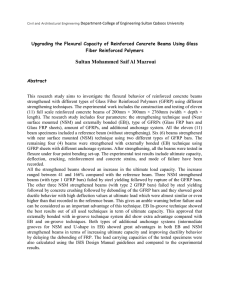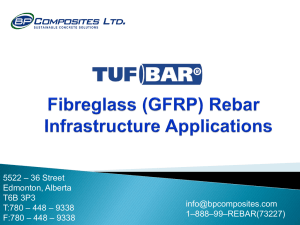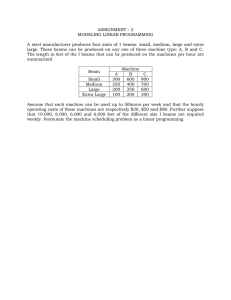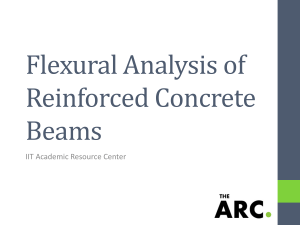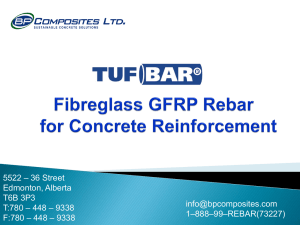IRJET- Effect of GFRP Rebars in RC Beams
advertisement
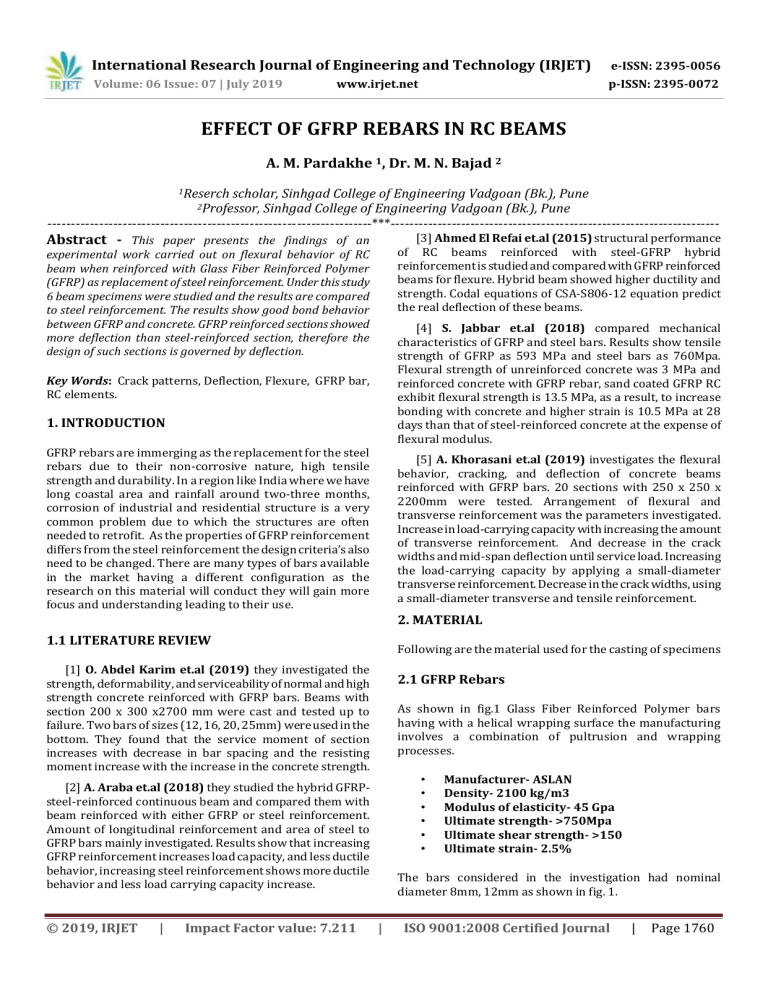
International Research Journal of Engineering and Technology (IRJET) e-ISSN: 2395-0056 Volume: 06 Issue: 07 | July 2019 p-ISSN: 2395-0072 www.irjet.net EFFECT OF GFRP REBARS IN RC BEAMS A. M. Pardakhe 1, Dr. M. N. Bajad 2 1Reserch scholar, Sinhgad College of Engineering Vadgoan (Bk.), Pune Sinhgad College of Engineering Vadgoan (Bk.), Pune ---------------------------------------------------------------------***---------------------------------------------------------------------2Professor, Abstract - This paper presents the findings of an [3] Ahmed El Refai et.al (2015) structural performance of RC beams reinforced with steel-GFRP hybrid reinforcement is studied and compared with GFRP reinforced beams for flexure. Hybrid beam showed higher ductility and strength. Codal equations of CSA-S806-12 equation predict the real deflection of these beams. experimental work carried out on flexural behavior of RC beam when reinforced with Glass Fiber Reinforced Polymer (GFRP) as replacement of steel reinforcement. Under this study 6 beam specimens were studied and the results are compared to steel reinforcement. The results show good bond behavior between GFRP and concrete. GFRP reinforced sections showed more deflection than steel-reinforced section, therefore the design of such sections is governed by deflection. [4] S. Jabbar et.al (2018) compared mechanical characteristics of GFRP and steel bars. Results show tensile strength of GFRP as 593 MPa and steel bars as 760Mpa. Flexural strength of unreinforced concrete was 3 MPa and reinforced concrete with GFRP rebar, sand coated GFRP RC exhibit flexural strength is 13.5 MPa, as a result, to increase bonding with concrete and higher strain is 10.5 MPa at 28 days than that of steel-reinforced concrete at the expense of flexural modulus. Key Words: Crack patterns, Deflection, Flexure, GFRP bar, RC elements. 1. INTRODUCTION GFRP rebars are immerging as the replacement for the steel rebars due to their non-corrosive nature, high tensile strength and durability. In a region like India where we have long coastal area and rainfall around two-three months, corrosion of industrial and residential structure is a very common problem due to which the structures are often needed to retrofit. As the properties of GFRP reinforcement differs from the steel reinforcement the design criteria’s also need to be changed. There are many types of bars available in the market having a different configuration as the research on this material will conduct they will gain more focus and understanding leading to their use. [5] A. Khorasani et.al (2019) investigates the flexural behavior, cracking, and deflection of concrete beams reinforced with GFRP bars. 20 sections with 250 x 250 x 2200mm were tested. Arrangement of flexural and transverse reinforcement was the parameters investigated. Increase in load-carrying capacity with increasing the amount of transverse reinforcement. And decrease in the crack widths and mid-span deflection until service load. Increasing the load-carrying capacity by applying a small-diameter transverse reinforcement. Decrease in the crack widths, using a small-diameter transverse and tensile reinforcement. 2. MATERIAL 1.1 LITERATURE REVIEW Following are the material used for the casting of specimens [1] O. Abdel Karim et.al (2019) they investigated the strength, deformability, and serviceability of normal and high strength concrete reinforced with GFRP bars. Beams with section 200 x 300 x2700 mm were cast and tested up to failure. Two bars of sizes (12, 16, 20, 25mm) were used in the bottom. They found that the service moment of section increases with decrease in bar spacing and the resisting moment increase with the increase in the concrete strength. 2.1 GFRP Rebars As shown in fig.1 Glass Fiber Reinforced Polymer bars having with a helical wrapping surface the manufacturing involves a combination of pultrusion and wrapping processes. • • • • • • [2] A. Araba et.al (2018) they studied the hybrid GFRPsteel-reinforced continuous beam and compared them with beam reinforced with either GFRP or steel reinforcement. Amount of longitudinal reinforcement and area of steel to GFRP bars mainly investigated. Results show that increasing GFRP reinforcement increases load capacity, and less ductile behavior, increasing steel reinforcement shows more ductile behavior and less load carrying capacity increase. © 2019, IRJET | Impact Factor value: 7.211 Manufacturer- ASLAN Density- 2100 kg/m3 Modulus of elasticity- 45 Gpa Ultimate strength- >750Mpa Ultimate shear strength- >150 Ultimate strain- 2.5% The bars considered in the investigation had nominal diameter 8mm, 12mm as shown in fig. 1. | ISO 9001:2008 Certified Journal | Page 1760 International Research Journal of Engineering and Technology (IRJET) e-ISSN: 2395-0056 Volume: 06 Issue: 07 | July 2019 p-ISSN: 2395-0072 www.irjet.net 4. RESULTS AND DISCUSSION Results of the four-point bending test are shown below Table -2: Experimental results of beams reinforced with steel and GFRP rebars Figure 1 GFRP Rebars S.N Load (KN) Deflection of beams with GFRP rebars (mm) Deflection of beams with steel rebars (mm) 1 0 0 0 Percentage increase in deflection of the beam with GFRP rebars w.r.to beam with steel rebar 0 2 2 0.3 0.4 -33.33 3 4 0.65 0.7 -7.7 4 6 1.1 1.1 0 5 8 1.35 1.25 +7.4 6 10 1.55 1.45 +6.45 7 12 1.8 1.6 +11.11 8 14 2 1.7 +15 9 16 2.1 1.8 +14.28 10 18 2.25 1.85 +17.77 11 20 2.85 1.95 +31.58 12 22 3.05 2 +34.43 2.2 Mix proportions for M30 grade concrete Cement = 340 kg/m3 Fly ash = 60 kg/ m3 Water = 190 kg/ m3 Fine aggregates = 810 kg/ m3 Coarse aggregate = 1112 kg/ m3 Water-cement ratio = 0.475 3. METHODOLOGY Both GFRP and steel-reinforced beams were designed using design manual 3 ISIS, Canada and IS 456-2000 respectively. Table 1 shows the details of the beam specimens. Table -1: Details of beam specimens for four-point bending test Beam designat ion B1 B2 Size of beam 150x150x70 0mm 150x150x70 0mm No. of specim ens Reinforce ment provided 13 24 3.8 2.05 +46.05 Reinforce ment type 14 26 3.95 2.1 +46.83 15 28 4.15 2.2 +46.99 3 2-8mm φ Steel 16 30 4.3 2.3 +46.51 3 1-8mm 212mm φ GFRP 17 32 4.55 2.35 +48.35 18 34 4.65 2.4 +48.38 19 36 5.2 2.5 +51.92 20 38 5.4 2.6 +51.85 21 40 5.9 2.75 +53.39 22 42 6.2 2.85 +54.03 23 44 6.35 2.9 +54.33 24 46 6.5 2.95 +54.61 25 48 6.7 3.05 +54.47 26 50 7 3.15 +55 27 52 7.15 3.25 +54.54 28 54 7.3 3.35 +54.1 29 56 7.5 3.4 +54.66 30 58 7.75 3.5 +54.83 31 60 7.9 3.65 +53.80 32 62 8.15 3.7 +54.60 These specimens were then cured for 28 days and tested for four-point bending test on a universal testing machine as shown in fig 2. Fig. 2 setup for four-point bending test © 2019, IRJET | Impact Factor value: 7.211 | ISO 9001:2008 Certified Journal | Page 1761 International Research Journal of Engineering and Technology (IRJET) e-ISSN: 2395-0056 Volume: 06 Issue: 07 | July 2019 p-ISSN: 2395-0072 www.irjet.net 33 64 8.3 3.75 +54.80 34 66 8.6 4 +53.48 35 68 8.8 4.1 +54.05 36 70 9.25 4.25 +55.15 37 72 9.7 4.35 +55.40 38 74 10.2 4.55 +55.40 39 76 10.85 4.7 +56.68 deflection as per the limit state of serviceability which is (length/360). For the GFRP reinforced beams, large deflections as compared to steel reinforced beams were seen at comparatively smaller loads. The first crack was observed at a load of 20KN. Service load calculated was 13 KN. 4.2 Effect of GFRP rebars on cracking pattern of RC beam The crack propagation was marked and monitored manually throughout the beam testing. As shown in Table 3 which show the first crack load and service load for steel and GFRP reinforced section. The difference of first crack load was nearly60- 65% more in case of steel-reinforced beams. As there was more deflection occurring in case of GFRP reinforced beams it was obvious to form cracks at a lower load as compared to the steel-reinforced sections where there was not much of deflection. Table 3 shows the first crack and service load and chart 1 shows Comparison of load vs deflection curves for steel and GFRP. As shown in fig. 3 and fig. 4 which shows the cracking pattern for steel and GFRP reinforced sections, In case of GFRP, reinforced beams some more minor cracked spaced at a lesser distance was then observed. The crack observe was below the loading points these cracks then propagated into the compression zone rapidly as the bar slip was occurring at the interface of bar and concrete. Wider cracks such as 1.5mm were seen in the GFRP reinforced beam at smaller loads such as 15-20KN, while the deflections for steelreinforced beam was seen very less for steel-reinforced beam cracking started at some higher loads i.e. 58KN. Chart -1: Comparison of load vs deflection curves for steel and GFRP Table -3: First crack and Service load for GFRP and steel RC beams Material First crack load (KN) GFRP Steel 20 58 Service load (KN)(@ 1.66mm) 13 19 4.1 Influence of GFRP rebars on the deflection of RC beams The deflection of GFRP reinforced beams was more by nearly 40-50% than in steel-reinforced beam. GFRP reinforced beams results in higher deflections (10-12mm). More stiff curves are obtained in term of the steel-reinforced beam than GFRP reinforced. As the cracks are formed the GFRP section the slip between bar and concrete is occurring resulting in more deflection at lower loads which was not seen in case of the steel-reinforced beams. The first crack was observed at a load of 20KN. Service load calculated was 13 KN.it is happening because of the low modus of elasticity of GFRP bars which is nearly 45 Gpa and also the bond strength of GFRP with concrete is not as strong as steel bars. Fig. 3 cracking pattern of the steel-reinforced beam For the steel-reinforced beam very less deflection (1-1.5mm) was seen at lower loads (1-12KN) which then turned into the first crack at the load of 58 KN. The service load calculated at the deflection of 1.66mm was observed to be 19 KN (The service load calculated is for the maximum allowable © 2019, IRJET | Impact Factor value: 7.211 Fig. 4 cracking pattern of GFRP reinforced beam | ISO 9001:2008 Certified Journal | Page 1762 International Research Journal of Engineering and Technology (IRJET) e-ISSN: 2395-0056 Volume: 06 Issue: 07 | July 2019 p-ISSN: 2395-0072 www.irjet.net 4.3 Effect of GFRP rebars on the failure pattern of RC beam REFERENCES [1] O. I. Abdelkarim, E. A. Ahmed, H. M. Mohamed, and B. Benmokrane, “Flexural strength and serviceability evaluation of concrete beams reinforced with deformed GFRP bars,” Eng. Struct., vol. 186, no. May 2018, pp. 282–296, 2019. As shown in Chart 1which shows the comparison of load vs deflection curves for steel and GFRP, both the material shows nearly linear behavior up to failure. The curve for steel RC beams was stiffer then GFRP beams, as the deflection was more in case of GFRP beams. The failure of the steel-reinforced beam was by yielding of steel followed by the crushing of concrete which was expected failure for under reinforced beams as they were designed as under reinforced sections. [2] A. M. Araba and A. F. Ashour, “Flexural performance of hybrid GFRP-Steel reinforced concrete continuous beams,” Compos. Part B Eng., vol. 154, pp. 321–336, 2018. [3] A. El, F. Abed, and A. Al-rahmani, “Structural performance and serviceability of concrete beams reinforced with hybrid ( GFRP and steel ) bars,” Constr. Build. Mater., vol. 96, pp. 518–529, 2015. The failure in GFRP reinforced beams was by crushing of concrete in the compression zone as they were designed as over reinforced sections. Bar slip with minor yielding of glass fibers was also seen at the failure of GFRP reinforced beams. The failure in GFRP reinforced beam was not sudden as were reported by many of the researchers; it was more of the desired failure. in case of the sand coated bar, the sand coating contributes to the bond strength of GFRP section and the slip which is occurring in helically wrapped bars in the present study is not that much and the sudden deboning of the sand coated layer occurs leading to the sudden failure of GFRP sections. [4] S. A. Jabbar and S. B. H. Farid, “Replacement of steel rebars by GFRP rebars in the concrete structures,” Karbala Int. J. Mod. Sci., vol. 4, no. 2, pp. 216–227, 2018. [5] A. M. M. Khorasani, M. R. Esfahani, and J. Sabzi, “The effect of transverse and flexural reinforcement on deflection and cracking of GFRP bar reinforced concrete beams,” Compos. Part B Eng., vol. 161, pp. 530–546, 2019. 5. CONCLUSIONS BIOGRAPHIES Author is a PG student perusing Masters in Structural Engineering at Sinhgad College of Engineering, Vadgaon, Pune. Based on the experimental investigation conducted following conclusions are made. 1. GFRP reinforced beams shows 40-50% more deflection as compared to steel reinforced beams. 2. The failure of GFRP reinforced sections is not sudden it is more of a desired failure. 3. Design of GFRP beam is mainly controlled by deflection and cracking due to the low modulus of elasticity of GFRP rebar. 4. Results show that GFRP can be used as internal reinforcement with some modification to design compared to steel design. Author is Professor at Sinhgad College of Engineering, Vadgaon, Pune. ACKNOWLEDGEMENT The authors wish to acknowledge Aslan for supplying FRP rebars used in this study as well as JK concrete for providing concrete material. The authors would also like to thank the authorities of the department of Civil Eng. SCOE, Pune for their kind help and support. © 2019, IRJET | Impact Factor value: 7.211 | ISO 9001:2008 Certified Journal | Page 1763

